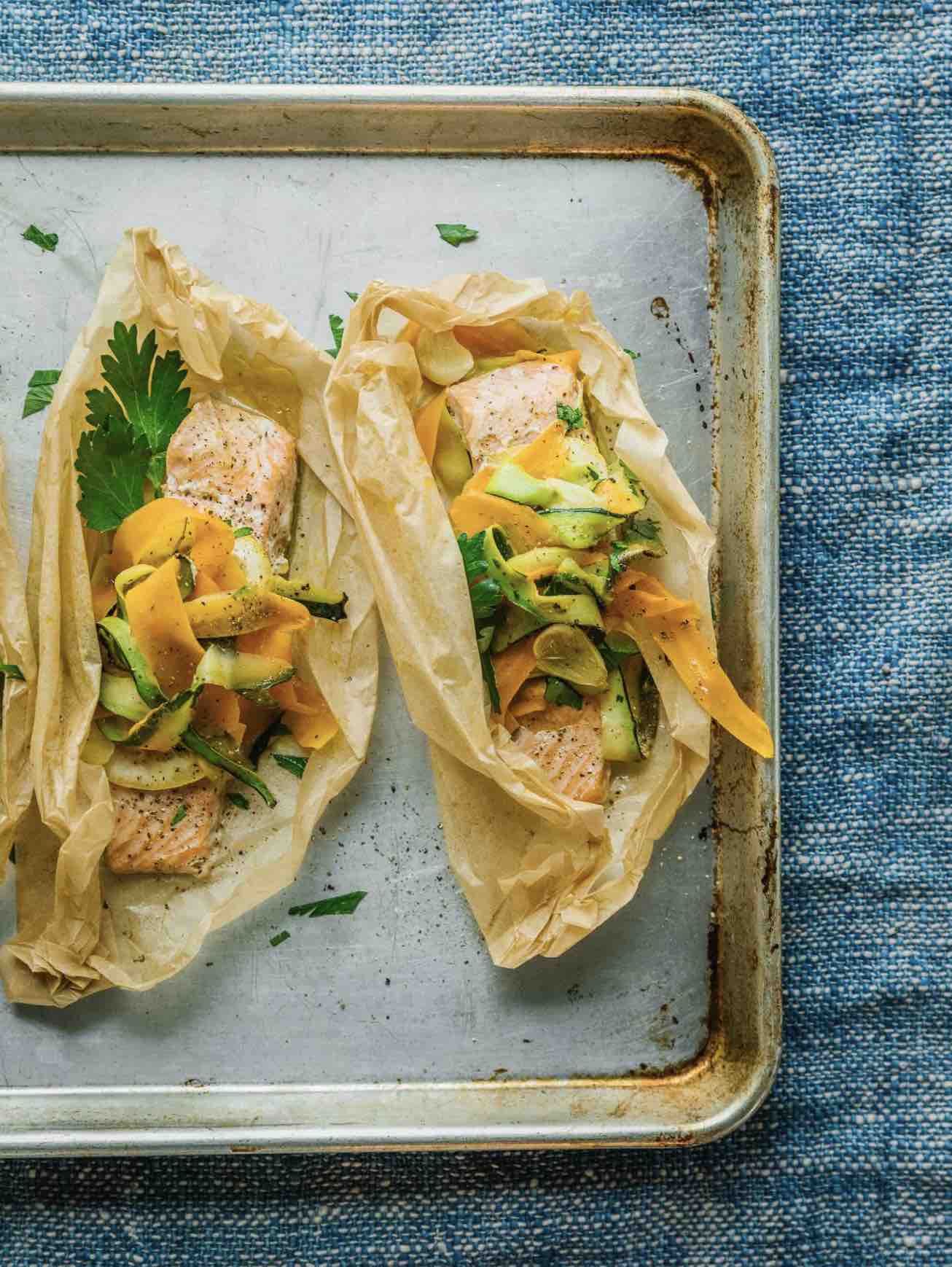 Fall in love with vegetables
Fall in love with vegetables
Amanda Cohen, chef/owner of Manhattan’s Dirt Candy – she’d rather call it a vegetable restaurant than a vegetarian restaurant—knew she had found her calling while working at the upscale Diner Bar in Spanish Harlem. “I was working with one other cook turning out up to 200 covers each night,” she told me. “That’s when I realized there was no going back.”
Cohen became a vegetarian as a teenager. “I wasn’t a feral child fending for myself, but I was definitely the member of my family who spent the most time in the kitchen,” she recalled. Living in Hong Kong in the ‘90’s—she calls it “the best food city on earth”— she fell in love with vegetables. “Everyone has a time in their life that shapes everything that follows, and for me this was it.” Growing up in a Jewish home, she realized “in Judaism almost every observance revolves around food,” and she envisioned turning Dirt Candy “into that rowdy, fun, delicious Rosh Hashanah dinner we all had when we were ten years old and the dining room was crowded, the noise level was high, and everyone was having a blast.”
The restaurant’s website explains the name: “Dirt Candy because vegetables are just candy from the dirt.” Ranked as one of the 100 Best Restaurants in New York City by the New York Times, Dirt Candy was the first vegetable restaurant in the city, garnering a Michelin star and a James Beard Nomination for Cohen, who was the first vegetarian chef to compete on Iron Chef: America, and her comic cookbook, “Dirt Candy: A Cookbook” (Clarkson Potter, $22), currently in its seventh printing, is the first graphic novel cookbook to be published in North America.
“Cooking vegetables is not the easiest path,” she noted. “It’s easy to take black truffles and put that on something, or caviar, and have people go, ‘Oh, my god, that’s amazing,’ but it’s hard to take zucchini and have somebody go, ‘That’s amazing.’”
“What we eat can prevent disease, help us feel good, function optimally, and even heal and restore our body,” writes Carly Knowles, Registered Dietitian Nutritionist, in “The Nutritionist’s Kitchen” (Roost Books, $24.95).
After college, Knowles moved to a remote village in Peru, with no running water or electricity and little fresh food, to work with a U.S. non-profit promoting healthy behavior change in rural and impoverished communities. “The diet in this rural village was extremely limited,” she explained, “causing serious and irreversible health issues.” When she discovered that many of the villagers had white spots in their eyes due to a vitamin A deficiency, a condition which could cause blindness, she had an epiphany. “I was inspired to study nutrition in more depth and learn how to transform everyday food into medicine.” Knowles went on to receive a master’s of science in nutrition from Bastyr University, the oldest accredited natural medicine college in the United States, and “The Nutritionist’s Kitchen” is the culmination of her scientific study as well as her real-life experience with her patients.
How to transform your food into medicine? “Start with real food comprising whole, unprocessed, and unrefined ingredients,” she advises. “Instead of relegating medicine to pharmaceuticals, make the choice to eat food with life-giving energy versus food that depletes you of that energy. Eat food that exists in nature, real food that you can picture living and growing in its whole form in nature before it makes its way to your grocery store or farmers’ market. Prioritize organic foods, both plant and animal, and buy seasonal produce.”
With over 60 seasonal recipes, including Coconut Curry Red Lentil Stew, Salmon en Papillote, Beef and Beet Borscht, Flourless Chocolate Almond Butter Brownies, “The Nutritionist’s Kitchen” is an approachable guide to supporting optimal health and wellness.
“My food philosophy is centered around the idea that food should taste good and bring you joy!” she writes. “My patients are always surprised when I say this. They often think that ‘nutritious food’ is bland and boring and that a dietitian only promotes diets and restrictions. I promote nutrition, of course, but not at the cost of sacrificing flavor or satisfaction.”
Salmon en Papillote
In French cuisine “en Papillote” refers to cooking or steaming food in parchment or paper pockets. You can substitute any type of fish in this recipe. Adjust cooking time as needed, depending on the thickness of the fish. Other seasonal vegetable variations include asparagus ribbons and basil, thinly sliced fennel and lemon, and thinly sliced orange and shallots.
Yield: 4 servings
Four (4–ounce) salmon fillets (skin on or off), washed and thoroughly dried
Sea salt and ground black pepper
1 small zucchini
2 large carrots
2 cloves garlic, peeled and thinly sliced crosswise
1 tablespoon olive oil
1 lemon, sliced paper-thin
Chopped flat-leaf parsley (garnish)
1. Cut four 18-inch-long pieces of parchment paper; fold each in half crosswise, creasing paper at fold. Using scissors, cut semicircle on folded parchment paper, using creased side as middle of circle. Discard pieces you cut off. When you open folded paper, you should reveal a symmetrical circle. Complete 4 parchment circles.
2. Preheat oven to 425°F. Salt and pepper salmon on all sides.
3. Using vegetable peeler, start at one end of zucchini (keep peel if organic). and peel long ribbons from top to bottom until you can’t comfortably hold and peel any more (about 1 cup). Place in medium-size mixing bowl. Repeat with carrots, peeling long carrot ribbons (about 1 cup). Add carrots to bowl with garlic and olive oil; toss until well combined.
4. Place one parchment circle on baking sheet; place 1 fillet skin side down (if skin on) on one-half of circle. Place two slices lemon on top. Top with small handful (1/4 cup) vegetable mixture. Fold other half of parchment over filling and crimp sides together along rounded edge, folding tightly to completely seal pocket while leaving some air space in center of pocket. Repeat with other fillets. Bake 10 to 12 minutes until fish is cooked, (less time for thinner pieces of fish and more for thicker pieces).
5. To serve, place 1 pocket on each dinner plate for diners to open (my preferred way), or unwrap pockets, remove salmon and vegetables, and serve them together on a platter. Garnish with parsley, and season to taste with salt and pepper.
Source: “The Nutritionist’s Kitchen” by Carly Knowles
 Butternut Squash Soup
Butternut Squash Soup
“At the restaurant, I roast spaghetti squash and add a little pile of it to the bottom of each bowl.”
Yield: 4 servings
1 1/2 teaspoons coriander seeds
1/2 cup pumpkin seeds
3 tablespoons extra-virgin olive oil
2 cups chopped yellow onions
2 tablespoons chopped garlic
3 tablespoons chopped peeled fresh ginger
2 teaspoons ground sambar or curry powder
1/2 jalapeño, seeded and chopped
1 stalk lemongrass, chopped
1 lemon, peel only, removed with a peeler
1 tablespoon salt
4 cups diced peeled butternut squash, with seeds
2 tablespoons sugar (optional)
Coconut cream (1 tablespoon per serving)
1. Preheat oven to 350°F.
2. In dry pan over medium heat, toast coriander seeds until fragrant, 5 minutes. Set aside.
3. Toast pumpkin seeds on baking sheet in oven until they turn golden brown and you hear them pop, about 15 minutes. Let cool, then grind into a powder.
4. Start a pot over medium heat with olive oil, onions, and garlic. Add 8 cups water and remaining ingredients except squash, sugar, and coconut cream. Bring to a boil over medium heat, then reduce heat to low, and simmer 30 minutes. Add squash and cook until fork-tender, about 20 minutes. Taste, and if it’s slightly bitter, add sugar a teaspoon at a time (up to 2 tablespoons). How much you need to add depends on sugar content of squash.
5. Pour contents of pot into baking dish and roast in oven until it reduces and a crust starts to form, about 1 hour.
6. Remove from oven and strain, then push through a chinois. Let cool to room temperature. Skim oil off top. Line chinois with cheesecloth and push through again to make sure all chunks are removed. Serve with dollop of coconut cream.
Source: “Dirt Candy” by Amanda Cohen & Ryan Dunlavey
Jlife Food Editor Judy Bart Kancigor is the author of “Cooking Jewish” (Workman) and “The Perfect Passover Cookbook” (an e-book short from Workman), a columnist and feature writer for the Orange County Register and other publications and can be found on the web at www.cookingjewish.com.






